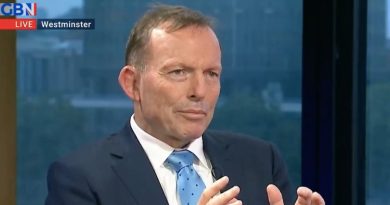Cold War may have ended, but the battle never did
Fox News Flash top headlines for February 28
Here are your Fox News headlines.
It was called a “sister city.”
The Berlin Wall had crashed into a pile of rubble. The Cold War was thawing. The Soviet Union would soon disintegrate as well.
I worked as a reporter for WKRC-AM in Cincinnati when I was in college in 1990. The Queen City formed a sister city partnership with Kharkiv, Ukraine. And on one spring morning in 1990, I drove to the Cincinnati airport to do a report as representatives of Kharkiv were about to land. Cincinnati officials waited at the gate (remember, this was years before 9/11) to greet their counterparts.
President Dwight Eisenhower pushed sister cities in the mid-1950s. It was an effort to help link American cities with cities abroad for cultural and sometimes economic exchanges. The program sometimes tried to connect cities that had similar cultures or geography or history.
RUSSIA INVADES UKRAINE: LIVE UPDATES
As I said, this was long before 9/11. So I drove to the airport and figured out the gate where the flight would land. There would be a little press conference, wedged between the digital TV screens announcing arrivals and departures.
Russian President Vladimir Putin delivers a video address from Moscow announcing the start of the military operation in eastern Ukraine on Feb. 24, 2022.
(Russian Pool/Reuters TV via Reuters)
I stood by the gate with my microphone in hand. The heavy metal door swung upon. And moments later, a small delegation strode down the jetway. An Eastern Orthodox religious leader from the candy-striped Annunciation Cathedral in Kharkiv stepped in front of everyone. Without prompting, he uttered a prayer, right there by the Delta sign. Incense poured from his brass thurible. It wafted through the terminal, mixing with the scent of caramel corn and hot dogs.
A few Cincinnati officials spoke. Some Ukrainian officials spoke – through an interpreter. And then everyone was on their way. I grabbed my legal-sized, yellow notebook. Plopped down at an adjacent gate waiting for a flight out of Tampa and knocked out a couple of scripts in long-hand. I then called the station from a payphone by the men’s room and filed my reports.
That day in 1990 wasn’t so much about what was said, who was there or what we smelled. That day was about the future.
The Soviet Union was still intact at that point. But everyone sensed things were going to be different.
I had been on the air the night the Berlin Wall fell in November 1989. I kept running into the studio to get live, special reports on the air from ABC News. They had multiple correspondents reporting from the Brandenburg Gate and Bonn. I distinctly recall one reporter signing off from “West Berlin.” A few days later, his outcue changed to just “Berlin.”
I was on the air on Christmas Day in 1989 when Romanians arrested and tried dictator Nicolae Ceausescu in Bucharest. They executed Ceausescu by nightfall.
The winds of change in Eastern Europe dominated nearly every geopolitical news story for years.
East and West Germany reunified into the new “Germany” in the fall of 1990. By the spring of 1991, I was a student in what had been East Berlin. One sunny day, I took a long stroll along the still remaining chunks of the Berlin Wall. I paused for quite a while by the famous graffiti painting on one section of the wall depicting Soviet leader Leonid Brezhnev and East German dictator Erich Honecker engaged in a kiss. I strode through an open Brandenburg Gate where so many Germans – from the east and west – clamored that night in November 1989, as the wall fell.
I was shocked while traveling through what had been East Germany. During one walk, my classmates and I stumbled upon a Soviet military base, complete with troops doing calisthenics early one morning.
This was NATO territory, at that stage, mind you. And Soviet troops were on the soil of a NATO member. My classmates spoke briefly with one soldier. He gave me a Soviet military cap and tie pin. I still have both today.
We boarded a train and went as far east we could go. We stayed a few nights in Prague. Then on to Budapest.
The world was changing.
Sometimes not for the better.
Civil war broke out in the former Yugoslavia in the summer of 1991. Serbia and Croatia went at it first. The bloody “ethnic-cleansing” conflict in Bosnia came later and drifted into the mid-‘90s.
There was a “coup” attempt against Soviet leader Mikhail Gorbachev in the summer of 1991. Gorbachev finally realized the gig was up. He dissolved the Soviet Union at the end of 1991.
Even though I was a “local” reporter, I did numerous “local” stories about the fall of Eastern Europe and the demise of the Soviet Union between 1989 and early 1992. I recall a heated debate at one symposium about why Poland was lagging behind the rest of Eastern Europe in democratic reforms – even though the “solidarity” movement began at the Gdansk shipyards in 1980.
I took a course in graduate school devoted to understanding the new 15, former Soviet republics. The class even assembled a survey of each of these new countries. Our body of work examining each republic was more comprehensive than anything that even the CIA assembled.
One professor brought Nikita Khrushchev’s son Sergei to deliver a lecture on campus. He was also in a class I was taking about the Soviet Union. One classmate and I joked that when Khrushchev walked in, we should remove our shoes and bang them on the desk in the middle of his remarks. Khrushchev’s father infamously rapped a shoe against his desk during the speech of a Filipino diplomat at the United Nations in 1960.
I covered various forums at local universities about the changing global environment and what this meant for the U.S.
I recall interviewing a local Ohio congressman in the early 1990s who talked of how the federal government could soon cut defense spending, having “won” the Cold War. Budget hawks and military doves characterized this opportunity as “the peace dividend.” A professor of musicology at the University of Cincinnati told me in one interview that political upheaval often drives creative and artistic profession. He suggested that we may soon see Hungarian and Eastern European folk music soar in popularity.
I was doing the early morning shift in late 1990 when news broke about diplomatic talks involving Soviet Foreign Minister Eduard Shevardnadze. As I wrote a story about Shevardnadze, my colleagues were stunned to learn that I knew he wasn’t Russian, but Georgian. A few years later, Shevardnadze became the first leader of an independent Georgia. I then wowed the rest of the newsroom, noting that Soviet leader Joseph Stalin was not Russian, but also Georgian like Shevardnadze.
If you were a reporter in those days, it helped to know things like that.
Hopes soared for the future.
The Baltic republics of Lithuania, Latvia and Estonia were the first former Soviet republics to embrace democracy. Lithuanian leader Vytautus Landsbergis and Czech leader Vaclav Havel were darlings of the West, regularly appearing in American media interviews.
The world had seemed to tip on its axis. The western world brimmed with optimism. That said, Russia was forced to slash defense spending and the nation plunged into a deep economic depression.
Russia and the former Soviet satellite countries lagged decades behind the capitalist West. Millions died in various proxy wars between the West and Eastern bloc. The Cuban Missile Crisis, Vietnam and fighting in Central America punctuated the Cold War.
But it was suggested, perhaps not accurately, that the West eventually prevailed – not militarily – but with “Madonna and Coke.”
The United States emerged as the world’s lone superpower.
The end of the Cold War also meant two fundamental, geopolitical shifts. For the first time in 500 years, the “Russian Empire” was no longer expanding. It was retracting. At the time, NATO began encroaching, practically to Russia’s doorstep. Poland, the Czech Republic and Hungary joined in the late 1990s. Bulgaria, Estonia, Latvia, Lithuania, Romania, Slovakia and Slovenia joined in 2004. The most recent nation to sign up was North Macedonia in 2020.
Such an obtrusion naturally made Russia uneasy. NATO now dominated spheres of influence once under Moscow’s purview.
However, by the mid-1990s, communism was on the charge again in Eastern Europe and the former Soviet republics. Voters were still experimenting with democracy. But they weren’t electing “small d” democrats.
The refrain in some quarters of Eastern Europe was that even though the communist system stumbled, at least they had food.
But after 9/11, the U.S. and the West suddenly faced a new enemy: terrorism.
Vladimir Putin began to methodically rebuild the Russian military and consolidate his power over more than 20 years. It is said today that Putin is trying to “rebuild the Soviet Union.”
That may not be completely true. But it’s close.
So why is a reconstituted Russia trying to rebuild parts of the Soviet Union? And if true, did the West squander the past three decades after prevailing in the Cold War?
Putin’s invasion of Ukraine has not completely erased the West’s Cold War “victory.” But one thing is certain: The West failed to curb the rise of Russia from the ashes. The same adversary the U.S. seemed to have vanquished more than three decades ago rallied. As a result, the U.S. and Western Europe now face the same foe from the Cold War.
The Cold War between the West the Soviet Union may have ended. But the battle never eroded.
Source: Read Full Article





